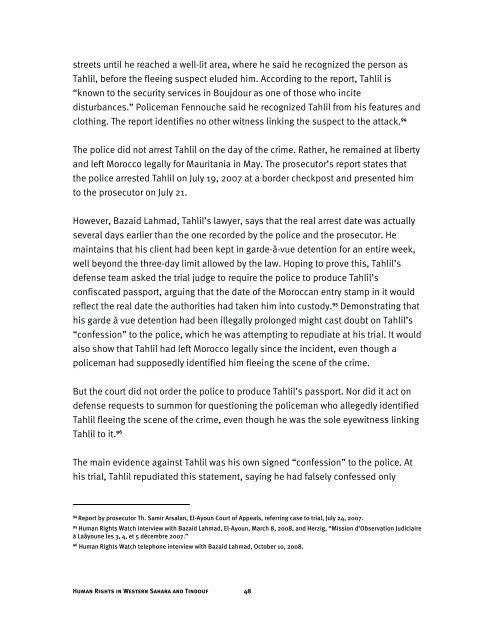Download full report with cover - Human Rights Watch
Download full report with cover - Human Rights Watch
Download full report with cover - Human Rights Watch
Create successful ePaper yourself
Turn your PDF publications into a flip-book with our unique Google optimized e-Paper software.
streets until he reached a well-lit area, where he said he recognized the person as<br />
Tahlil, before the fleeing suspect eluded him. According to the <strong>report</strong>, Tahlil is<br />
“known to the security services in Boujdour as one of those who incite<br />
disturbances.” Policeman Fennouche said he recognized Tahlil from his features and<br />
clothing. The <strong>report</strong> identifies no other witness linking the suspect to the attack. 94<br />
The police did not arrest Tahlil on the day of the crime. Rather, he remained at liberty<br />
and left Morocco legally for Mauritania in May. The prosecutor’s <strong>report</strong> states that<br />
the police arrested Tahlil on July 19, 2007 at a border checkpost and presented him<br />
to the prosecutor on July 21.<br />
However, Bazaid Lahmad, Tahlil’s lawyer, says that the real arrest date was actually<br />
several days earlier than the one recorded by the police and the prosecutor. He<br />
maintains that his client had been kept in garde-à-vue detention for an entire week,<br />
well beyond the three-day limit allowed by the law. Hoping to prove this, Tahlil’s<br />
defense team asked the trial judge to require the police to produce Tahlil’s<br />
confiscated passport, arguing that the date of the Moroccan entry stamp in it would<br />
reflect the real date the authorities had taken him into custody. 95 Demonstrating that<br />
his garde à vue detention had been illegally prolonged might cast doubt on Tahlil’s<br />
“confession” to the police, which he was attempting to repudiate at his trial. It would<br />
also show that Tahlil had left Morocco legally since the incident, even though a<br />
policeman had supposedly identified him fleeing the scene of the crime.<br />
But the court did not order the police to produce Tahlil’s passport. Nor did it act on<br />
defense requests to summon for questioning the policeman who allegedly identified<br />
Tahlil fleeing the scene of the crime, even though he was the sole eyewitness linking<br />
Tahlil to it. 96<br />
The main evidence against Tahlil was his own signed “confession” to the police. At<br />
his trial, Tahlil repudiated this statement, saying he had falsely confessed only<br />
94 Report by prosecutor Th. Samir Arsalan, El-Ayoun Court of Appeals, referring case to trial, July 24, 2007.<br />
95 <strong>Human</strong> <strong>Rights</strong> <strong>Watch</strong> interview <strong>with</strong> Bazaid Lahmad, El-Ayoun, March 8, 2008, and Herzig, “Mission d’Observation Judiciaire<br />
à Laâyoune les 3, 4, et 5 décembre 2007.”<br />
96 <strong>Human</strong> <strong>Rights</strong> <strong>Watch</strong> telephone interview <strong>with</strong> Bazaid Lahmad, October 10, 2008.<br />
<strong>Human</strong> <strong>Rights</strong> in Western Sahara and Tindouf 48


